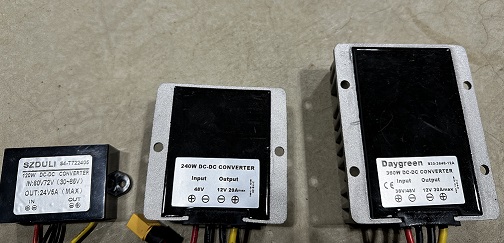
How to Reduce 24 volts to 12 volts?
Table of Contents
24 volts can be efficiently reduced to 12 volts by using a buck converter.
Reducing a 24-volt input to 12 volts is a common requirement in many electronic systems and devices. There are two main methods to achieve this: using a linear regulator or a switch mode regulator, such as a buck converter. While both types of regulators can accomplish the task, there are differences in their efficiency, heat generation, and flexibility.
How to reduce 48 volts to 12 volts or 48 volts to 24 volts, and how to increase 12 volts to 24 volts? Find out more details in our other articles.
Can I Use A Linear Regulator To Reduce 24 Volts To 12 Volts?
Probably not. Linear regulators operate by dissipating excess voltage as heat. In this case, reducing 24 volts to 12 volts would require burning off half the voltage, which generates significant heat. The amount of heat generated is determined by the product of the current and the voltage difference.
So, a larger voltage drop between the input and output leads to more heat loss. While linear regulators are simple and relatively inexpensive, their efficiency can be compromised due to this heat generation, especially in applications with large voltage differences. Generally, linear regulators are only good for low voltage, low current applications.
Is A Switch Mode Regulator Better Than Linear?
Yes. In a linear regulator, the difference in voltage between the input and the output will be directly related to how much heat is produced within the regulator. While it's true that in switch mode buck converter regulators, the distance between the input and output voltages does have an effect on efficiency, efficiency is not directly proportional to that difference. So a buck converter is able to take 24 volts down to 12 volts and have absolutely no heat or efficiency problems until you start pulling way more current than the regulator is designed to handle.
Switch mode regulators, such as buck converters, offer a more efficient solution for reducing voltage. In these regulators, the efficiency is not directly proportional to the voltage difference between the input and output. As a result, a buck converter can reduce 24 volts to 12 volts without experiencing significant heat or efficiency problems until the current draw exceeds the regulator's design capacity.
What's The Best Way To Reduce 24 Volts To 12 Volts?
There are several different types of buck converters you can get. Some are adjustable, some are constant voltage, some are constant current, others are fixed, some are in casings, some are just boards or modules. There are many options.
[[ aff type=aff ~ link=https://amzn.to/3AQi3R9 ~ title=`24v to 12v Buck Converter` ~ image=https://admin.cellsaviors.com/storage/24v-to-12v-buck-converter.jpg ~ description=`Easy to use 24v to 12v buck converter. A few available amperage ratings from this seller. ` ~ height=small ~ buttonText=`Check Price` ]]
For applications that require a fixed output voltage of 12 volts with a stable input voltage of around 24 volts, a fixed mode non-adjustable regulator is an excellent option. These regulators typically contain a constant voltage buck converter, providing a more efficient and cooler solution compared to a linear regulator.
When selecting a buck converter, it's super important to consider factors such as the required output current, size, and cost. High-quality buck converters can be more than 90% efficient, which minimizes energy waste and heat generation.
What Is Regulator Noise?
Switch mode regulators are active devices that are constantly performing functions at high frequencies. This causes an unavoidable amount of noise on the line called ‘ripple’. Buck converters have built in output capacitors that work to stabilize the output voltage and bring voltage ripple to a minimum.
Linear regulators produce much less ripple than buck converters, but for the overwhelming majority of applications, this amount of noise is completely and totally negligible.


